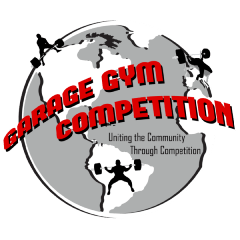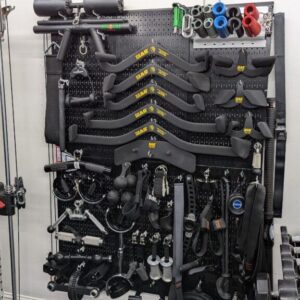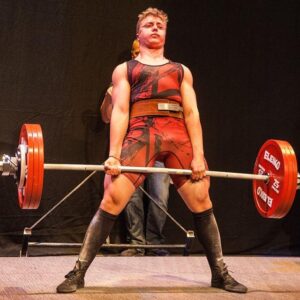Eat Big, Lift Bigger – 5 Tips To BOOST Your Powerlifting Diet
Powerlifters got a bad wrap for years as the super-heavyweights that couldn’t touch their toes or make it up a flight of stairs without taking breaks. To be fair, it was an accurate generalization as powerlifters rarely “looked” like they lifted weights. But in more recent years we’ve had guys and gals that were a few weeks out of a bodybuilding competition and smashing all time World Records. You don’t get jacked AND strong without putting at least some focus on your diet. So this week I asked my coaching crew about a powerlifting diet. More specifically, “How Important Is A Diet to Powerlifters?“
From a scale of Not at all to the Most Important Thing, how much time and effort should be allocated here? Are there certain things that are crucial and others that aren’t? What tips and tricks can we use to make it work while focusing on PRs on the platform? And today we are going to dive into a few of the best responses on this topic.
Table of Contents
Key Notes
The strongest lifters aren’t the ones who train the hardest; they’re the ones who recover the best. A strategic Powerlifting Diet will help you do that.
Transparency Note
Some of the items and links in this article might be affiliate links, or might be linked to a Sponsor of the Garage Gym Competition. These links and sponsorships help fund the website, the competition itself, the newsletter, non-profit donations, and everything else we do FOR FREE here at the GGC. I like to be transparent so you know what is up. I appreciate the support if you choose to use the links.

GGC Coaches Roundtable
How important is diet to powerlifters?
I believe diet is absolutely crucial. Whether you’re trying to build muscle for increased strength or you’re already at the top of your weight class, nutrition plays a major role in your success. Getting enough calories to fuel performance and sufficient protein to aid muscle recovery is essential.
The old mindset of “mass moves mass” dominated powerlifting for years, but the sport has evolved to prioritize quality nutrition for strength, recovery, and longevity. As a Super-heavyweight competitor, I once ate anything to gain size, but I’ve learned that functional weight matters more than mass alone. Proper nutrition optimizes muscle growth, energy levels, body composition, and joint health while preventing long-term metabolic issues. Powerlifting isn’t just about getting bigger—it’s about getting stronger and moving weight efficiently. The right fuel can elevate performance, and every lifter, regardless of weight class, should see nutrition as a vital tool for success.
When I started powerlifting it was drilled into my brain that mass moves mass. The bigger you are the easier it is to move more mass. In that infinite desire to gain size and strength we run into a conundrum of how much is too much? We don’t need “fat strongmen”.
This is where diet takes center stage. As much as we love to crush sour patch kids and honey packets at meets, we have to learn to dial it in every other day. Research has shown that anthropomorphic measurements can lead us to predict successful lifts. Furthermore data tells us fat free mass is a better predictor than “mass”. This is where diet can take over and help dial in strength gains as efficiently as possible.
Kirk Thomas
A common misconception about powerlifters is that diet takes a backseat because the focus is on performance rather than aesthetics. But the truth is, nutrition is just as strategic for strength athletes as it is for bodybuilders or endurance competitors. In fact, a well structured diet can make the difference between stagnation and progress on the platform.
Powerlifting isn’t just about moving heavy weights—it’s about optimizing strength, recovery, and staying within a weight class. That means dialing in nutrition to fuel peak performance without unnecessary weight gain. Simply eating in a calorie surplus isn’t enough; powerlifters need to understand what to eat and when to eat it for maximum effect.
Ok, so now we can all agree that nutrition and diet are important factors for powerlifters. So the next question is, what do we do?
Step 1 – Track Your Macros
When you step into the gym to smash your personal records, your body isn’t just lifting weights—it’s burning fuel. A proper diet isn’t just for beach bodies; it’s the secret sauce behind every successful powerlifting session. Let’s break down the science behind macronutrients, hydration, and various diet strategies to help you find what fuels your gains best. Every rep, every set, and every recovery session depends on the three macro-nutrients that power your body:
Protein: The Muscle Repair Squad

When you lift heavy, your muscles experience tiny tears. Protein supplies the amino acids needed to repair and rebuild these fibers, making your muscles stronger over time. Research suggests that powerlifters should aim for around 1.6-2.2 grams of protein per kilogram of body weight (Phillips, 2017). Stock up on lean meats, eggs, dairy, fish, or plant-based proteins like tofu and lentils to keep your muscles fueled for growth.
Carbohydrates: The High-Octane Fuel

Carbs are the primary energy source for your workouts, replenishing muscle glycogen stores for that extra burst of power. Complex carbs like oats, rice, and whole grains provide long-lasting energy, while simple carbs (think fruits) can offer a quick energy boost pre-workout. Studies indicate that the right amount of carbohydrates can significantly enhance performance during high-intensity lifts (Slater & Phillips, 2011).
Fats: The Hormone Helpers

Often overlooked, fats play a crucial role in hormone production, including testosterone, which is vital for muscle growth. Healthy fats—found in avocados, nuts, olive oil, and fatty fish—should make up about 20-35% of your daily calories (Volek et al., 2006). These fats also provide a steady energy supply, keeping you strong during longer training sessions.
Step 2 – Hydrate!

You might be hitting your macro goals, but if you’re not properly hydrated, your performance could tank. Even a slight dehydration (as little as 2% of your body weight) can lead to significant drops in strength and focus (Casa et al., 2010). Water is essential for nearly every bodily function, including muscle contractions and temperature regulation. During intense training, you lose electrolytes like sodium, potassium, and magnesium through sweat, which are critical for nerve function and muscle performance.
Aim for 3-4 liters of water per day, and increase that amount on heavy training days. Incorporate electrolyte-rich beverages if your workouts are especially long or sweaty (Sawka et al., 2007).
Step 3 – Fuel Your Workouts

Pre-workout meals should prioritize quick-digesting carbs and moderate protein to ensure energy levels stay high during heavy lifts. Post-workout, a combination of protein and carbs is critical for muscle repair and glycogen replenishment. But just as important is hydration—specifically, maintaining electrolyte balance.
Sodium, potassium, magnesium, and calcium play crucial roles in muscle contractions, nerve signaling, and preventing cramps. Without proper electrolyte intake, strength output and endurance suffer, and recovery slows down.
Step 4 – Take Care of Your Body

Beyond fueling workouts, diet plays a major role in joint and tendon health, which is often overlooked in strength sports. Heavy lifting puts significant stress on connective tissues, and without the right nutrients, wear and tear can lead to chronic inflammation or injuries like tendinitis.
Collagen, especially when paired with vitamin C, helps maintain tendon integrity and elasticity. Omega-3 fatty acids reduce joint stiffness and inflammation, while vitamin D supports bone density and reduces the risk of stress fractures.
Additionally, antioxidants from foods like fruits and vegetables can help combat oxidative stress, keeping lifters healthy and mobile for the long haul.
Step 5 – Find a Powerlifting Diet Strategy That Works FOR YOU

There’s no one-size-fits-all diet for powerlifters, and different approaches work for different athletes (some ideas below). You want to make sure you are getting consistent protein consumption. This is crucial for muscle repair and growth. Without sufficient protein, your recovery suffers, and so does your strength.
Get enough energy from carbs and fats to support your activity level and weight goals. Under-fueling can lead to energy deficits and decreased performance. And keep hydrated through water and balanced electrolyte consumption.
High-Carb Diet
Many powerlifters rely on a high-carb, moderate-protein, moderate-fat diet to ensure ample glycogen stores for intense workouts (Helms et al., 2014). This approach supports sustained energy levels and effective recovery.
Ketogenic & Low-Carb Diets
Some athletes experiment with low-carb or ketogenic diets, using fats as their primary fuel source. While this approach can be effective for fat loss and maintaining steady energy levels, it might compromise glycogen availability, potentially affecting maximal lifting performance (Wilson et al., 2017).
Intermittent Fasting (IF)
IF is another strategy that some powerlifters use to manage body fat while preserving strength. As long as overall calorie and protein intake remain adequate, intermittent fasting can work without detriment to performance (Tinsley et al., 2019).
IIFYM
One of the more popular approaches, If It Fits Your Macros, sometimes referred to as a flexible dieting strategy, is a diet that focuses on the key concepts of adequate protein, a balance of carbs and fats, plenty of veggies and fruits, but without a healthy focus on letting you make your own decisions. In more recent years this is commonnly referred to as having a healthy relationship with food.
Choosing quality foods 80% of the time, and leaving room for fun stuff the other 20%, but making sure that you still eat an overall balanced diet that keeps you healthy, in one piece, and moving forward on your goals.
Bonus Tip – Optimizing Meet Day Nutrition
Competition day demands peak strength, and carbohydrate intake is crucial for ensuring maximal power output. Powerlifters rely on stored muscle glycogen for explosive movements, and depleting these stores too early in the meet can lead to fatigue by the final deadlift attempt. Strategic carb loading in the days leading up to the meet—focusing on complex carbohydrates like rice, oats, and potatoes—helps maximize glycogen storage.
During the meet itself, quick-digesting carbs such as rice cakes, bananas, honey, or sports drinks provide rapid energy between attempts without causing bloating or sluggishness. Pairing these with electrolytes helps maintain hydration and prevent muscle cramping under maximal loads. Properly timed carbohydrate intake ensures that strength levels remain high from squat to deadlift, allowing lifters to hit their biggest numbers when it matters most.
Wrap Up
Strength is a technical adaptation, but without proper recovery—fueled by smart nutrition—progress stalls. The strongest lifters aren’t just the ones who train the hardest; they’re the ones who recover the best.
Matt Wenning says something I love ” it’s not what you do in the gym. But what you can recover from”.
That’s why diet—and a strategic approach to hydration, joint health, and energy management isn’t just important… it’s essential for powerlifters!
Authors & Contributors
This article was a joint venture by multiple GGC Coaches and Contributors.
Chuck Walton – Shamrock Fit – Strength and nutrition coach
James Wundrak – top_pin_performance
📌Enjoy Powerlifting? Want to enter a FREE competition with thousands of dollars in prizes and donations to non-profits? Check out our next event!
🏅 Own a home gym? Like to save money? Check out my full list of discount codes.
References
Phillips, S. M. (2017). Protein “requirements” beyond the RDA: implications for optimizing health. Applied Physiology, Nutrition, and Metabolism.
Slater, G., & Phillips, S. M. (2011). Nutrition guidelines for strength sports: sprinting, weightlifting, throwing events, and powerlifting. Journal of Sports Sciences.
Volek, J. S., et al. (2006). Dietary fat and testosterone. Nutrition & Metabolism.
Casa, D. J., et al. (2010). National Athletic Trainers’ Association position statement: fluid replacement for athletes. Journal of Athletic Training.
Sawka, M. N., et al. (2007). American College of Sports Medicine position stand: exercise and fluid replacement. Medicine & Science in Sports & Exercise.
Helms, E. R., et al. (2014). Evidence-based recommendations for natural bodybuilding contest preparation: nutrition and supplementation. Journal of the International Society of Sports Nutrition.
Wilson, J. M., et al. (2017). The effects of ketogenic diets on exercise metabolism and physical performance in off-road cyclists. Journal of Strength and Conditioning Research.
Tinsley, G. M., et al. (2019). Intermittent fasting and resistance training: a systematic review of the literature and meta-analysis. Sports Medicine.
Additional Resources
Mass Moves Mass? – https://pmc.ncbi.nlm.nih.gov/articles/PMC7745913/
The Renaissance Diet 2.0 by Dr. Mike Israetel, Dr. James Hoffmann, and Dr. Melissa Davis
Covers evidence-based nutrition principles for strength athletes, including macronutrient timing, caloric intake, and body composition management
Powerlifting Foundations & Methods by Boris Sheiko with Dr. Mike Israetel and Dr. Derek Wilcox
Sheiko emphasizes nutrition for recovery, weight management, and sustaining energy for high frequency training. He uplifts how proper nutrition maintains strength and fueling right supports recovery and long-term performance.
The 10 Commandments of Powerlifting by Ernie Frantz
Frantz stresses eating for strength, longevity, and overall health rather than just size. He uplifts that strength matters more than just gaining mass and Good nutrition supports power output and career longevity



